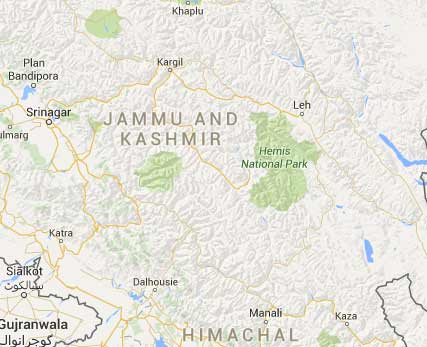Today is a historic day in the history of 70 years of independent India. Jammu and Kashmir and Ladakh, known as the paradise of the country, have become Union Territories from today. After the government of India paralyzed the forces of Article 370 on 5 August, Jammu and Kashmir and Ladakh have become two separate states from today to 31 October. With this, many laws made by Parliament will be implemented in the state. Under this, there will be an assembly in Jammu and Kashmir and Ladakh union territory. Today is the birth anniversary of Iron Man Sardar Vallabhbhai Patel, who has been instrumental in joining Jammu and Kashmir in India.
A gazette has been issued by the Central Government declaring Jammu and Kashmir and Ladakh as two Union Territories, with the signature of President Ramnath Kovind. Jammu and Kashmir has become a union territory, as well as its reorganization also took place.
The date for the state’s reorganization to take effect was kept on 31 October, which is the birth anniversary of Sardar Patel, the first Home Minister of the country. The re-birth of Jammu and Kashmir on the birthday of Sardar Patel, an iron man who built a strong India by uniting 565 princely states at the time of independence, is historic.
What has changed in Jammu and Kashmir from today?
1. Jammu and Kashmir, which remained a full state till now, has been transformed into two separate union territories from Thursday, 31 October. The area of Jammu and Kashmir is separate and the area of Ladakh have become two separate union territories.
2. Under the Jammu and Kashmir State Reorganization Act, Ladakh has now become a union territory without assembly while Jammu and Kashmir will be a UT with a Legislative Assembly.
3. Till now, there was a Governor’s post in Jammu and Kashmir, but now both Union Territories will have Lt. Governors. Girish Chandra Murmu has been appointed as the Lt. Governor for J&K and Radha Krishna Mathur for Ladakh.
4. Now both the states will have the same High Court but the Advocate General of both the states will be different. Government employees will have the option to choose either of the two Union Territories.
5. Most of the central laws were not applicable in the state, now after becoming a union territory, at least 106 central laws will be applicable in both Jammu and Kashmir and Ladakh UT’s.
6. This includes the Central Human Rights Commission Act, the Right to Information Act, and the law to prevent the damage to public property along with the schemes of the Central Government.
7. After the removal of the 35-A, which is the right of permanent residents of the state on land and government jobs, there will be a change in at least 7 laws related to land in Union Territory of Jammu and Kashmir.
8. Under the State Reorganization Act, about 153 such laws of Jammu and Kashmir will be abolished, which were made at the state level. However, 166 laws will still remain in force in both union territories.
Changes in administrative and political system as well
9. With the reorganization of the state, the administrative and political system of the state is also changing. In Jammu and Kashmir, where the assembly has been maintained along with the creation of a union territory. As compared to earlier, the tenure of the assembly will be 5 years instead of 6 years like the rest of the country.
10. Along with Scheduled Castes, now seats will also be reserved for Scheduled Tribes.
11. Previously, 24 ministers could be appointed in the cabinet, now like other states, more than 10% of the total members can not be made ministers.
12. Earlier there was also a Legislative Council in the Jammu and Kashmir Assembly, it will not happen now. However, there will be no impact on the number of Lok Sabha and Rajya Sabha seats coming from the state.
13. 5 Lok Sabha MPs will be elected from Union Territory of Jammu and Kashmir and one from Union Territory of Ladakh. In the same way only 4 MPs of Rajya Sabha will be elected from the Union Government of Jammu and Kashmir as before.
Election Commission can start the process of delimitation
14. It is also a big thing that after 31 October, the Election Commission can start the process of delimitation in the state. In which geographical, social and economic points can be taken care of with the population.
15. Till now, elections were held in 87 seats in Jammu and Kashmir. There were 4 seats in Ladakh, 46 in Kashmir and 37 in Jammu. By removing 4 seats of Ladakh, there are now 83 seats left in Union Territory of Jammu and Kashmir, in which delimitation is to be done.
Assembly seats may increase in Jammu and Kashmir
According to the proposed delimitation, the Assembly of Union Territory Jammu and Kashmir may increase by 7 seats. With the increase of 7 seats, there will be 90 seats in the Union Territory of Jammu and Kashmir. It is believed that the seats in Jammu region will increase, because it has always been said that Jammu does not get full representation. Jammu division has a population of 69 lakhs, and from there there are 37 seats while the Kashmir valley has a population of 53 lakhs, and from there there are 43 seats.
The new Kashmir whose slogan Prime Minister Narendra Modi has already given, has now started. The hope is that Jammu and Kashmir will be freed from the bloodshed in which Pakistan and its agents have put on Kashmir. At the same time, the challenge is also how much time it will take for the people of Kashmir Valley to join this change.

